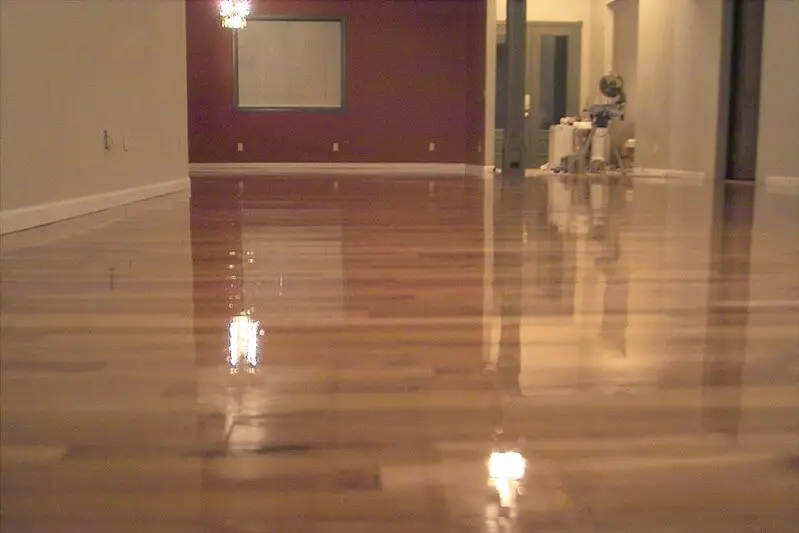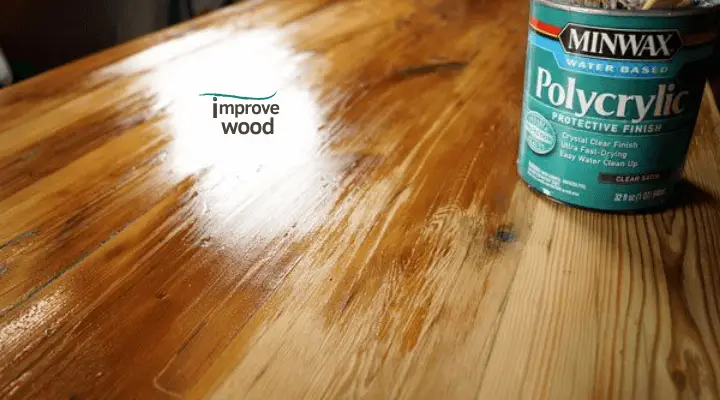Polyurethane drying time refers to the amount of time it takes for polyurethane to dry to the touch. This is crucial information as it allows for light traffic and enables the application of a second coat. Therefore, it’s important to have a precise understanding of the drying time for polyurethane. In this article, we will examine the drying and curing times of polyurethane, as well as the factors that can affect these times.
Oil-based vs water-based poly drying times
The formulation of a polyurethane finish can affect its drying times in a big way. For example, water-based polyurethanes are by design the fastest-drying polyurethanes on the market. Water-based polyurethane dries at about 2hrs for most brands. It even dries faster if applied using a good spraying system. Oil-based poly on the other hand may take up to 24 hours for most brands to dry.
| Water-Based Polyurethane | Oil-Based Polyurethane | |
|---|---|---|
| Brushed Application | 2-4 hours | 24-48 hours |
| Sprayed Application | 1-2 hours | 24 hours |
| Cure Time | 24-48 hours | 3-7 days |
| Safe to Place Objects | 24-48 hours | 7 days |
Note that the cure time and safe-to-place objects column values are estimates and may vary depending on several factors such as temperature, humidity, and the thickness of the applied coat.
How long does polyurethane take to dry between coats?
Determining how long to wait before applying the next coat of polyurethane can depend on several factors, such as the type of polyurethane used, temperature, humidity, and thickness of the previous coat. In general, water-based polyurethane dries faster than oil-based polyurethane, typically taking at least 2 hours before it can be recoated. On the other hand, oil-based polyurethane can take around 24 hours or more to dry before it can receive another coat.
For more detailed information on the recommended drying times between polyurethane coats, we have an article that you may find helpful.
| Water-Based Polyurethane | Wipe-On Polyurethane | Oil-Based Polyurethane | |
|---|---|---|---|
| Before Next Coat | 2-4 hours | 2-3 hours | 24-48 hours |
Drying time of different water-based polyurethane brands
Different brands of water-based polyurethane will dry, cure and be ready for recoat at different rates as can be seen in the table below. Also, notice that there is a difference between drying time and curing time for polyurethane. the discrepancies between the two will be addressed.
| Dry Time | Cure Time | Recoat Time | |
|---|---|---|---|
| Minwax Polycrylic | 2 hours | 4 days | 2 hours |
| Minwax Helmsman Spar Urethane | 8-10 hours | 1-3 days | 8-10 hours |
| Varathane Ultimate Polyurethane | 0.5-2 hours | 3 days | 4 hours |
| Minwax One Coat Polyurethane | 2 hours | 1-3 days | – |
| Minwax Wipe-On Poly | 2 hours | 24 hours | 2 hours |
| Minwax Oil-Modified Polyurethane | 2 hours | 3 weeks | 2 hours |
| Varathane Triple Thick Polyurethane | 2 hours | 48 hours | 2 hours |
| CrystaLac Extreme Protection Polyurethane | 30 min-1 hour | 24 hrs | 1 hours |
| RUST-OLEUM Varathane Diamond | 30 min-1 hour | 24 hrs | 1 hours |
| General Finishes High Performance | 30 min-1 hour | 21 days | 2 hours |
| Deft Water-Based Polyurethane | 2 hour | 4 days | 2 hours |
| General Finishes Enduro-VAR | 3-4 hour | 21 days | 4+ hours |
| ZAR 32512 Water Based Polyurethane | 30 min | 7 days | 2 hours |
Polyurethane Curing Time vs Drying Time
Polyurethane Drying Time
When polyurethane is applied to a surface, it begins to dry as the solvents in it evaporate. Drying is when the external coating of polyurethane hardens. It’s important to note that dried polyurethane is not cured polyurethane. You can tell when polyurethane has dried when it is no longer tacky and does not appear wet.
However, just because the polyurethane is dry doesn’t mean the surface is ready for use. Applying too much pressure or weight can damage the finish. Therefore, it’s best to avoid using the surface heavily until it has fully cured.
Polyurethane Curing Time
Curing, on the other hand, is when the polyurethane has completely hardened. During curing, the oils in the polyurethane are fully exposed to oxygen and undergo a complete chemical reaction, resulting in a hardened finish.
Cured polyurethane is the final, hardened finish that allows you to exert hard use on the surface without damaging it. Curing is a longer process than drying and can take anywhere from a day to almost a month, depending on the type of polyurethane used and the environmental conditions.
How to speed up the drying time for polyurethane
There are a few things that can be done to speed up the drying time of polyurethane. One of the easiest to identify as per our table above is the method of application.
1. Atomizing polyurethane to speed up drying time and application.
The mode of applying poly greatly affects the dying time of poly. Take oil-based poly for example, if applied using a spraying system the atomized poly dries faster than when applied with a brush.
If you would like to know how to get started on spraying poly check out our guide for the best spray guns for polyurethane.
While spraying poly is a great way of speeding up its drying time it’s a little expensive to set up and may not be convenient for a one-time finish job. Here are other affordable ways to speed up poly
2. Thinning polyurethane to make the coat lighter.
The thickness of polyurethane affects how first it will dry. Thining your poly with mineral spirits can make it dry faster.
However, this is done at the compromise of the protective ability. The more you thin your poly the less protective and the more coats you will need to build.
As a guide when thinning poly always remember that most wipe-on polyurethane is just thinned 50/50 with mineral spirits. Try to keep the mineral spirits lower for better protection. Below is a video on how to thin poly.
3. Brush evenly with consistent thickness
Maintaining a consistent thickness ensures that the surface dries evenly. Runs, sags, and bumps are notoriously known to cause slow drying and curing.
Brushing any of these imperfections not only helps your poly dry more evenly faster but also lessens the task of sanding to a smooth surface before the next coat.
4. Warm the workshop
Warming your workshop can also help the poly dry faster. You can use a heater but make sure that the rugs and mineral spirits are wrapped in a bag and away from the heater to avoid fire outbreaks.
A blower may also be used but make sure the workshop is dust free lest dust particles settle in the yet-to-dry poly.
Factors that affect the drying and curing times of polyurethane.
1. Type of polyurethane.
Drying times can vary not only between water-based and oil-based polyurethane but also within the same type. This is because manufacturers may use different formulas for their products, which can lead to varying drying times.
2. Surface type
Drying times for polyurethane can vary depending on the surface type, such as plastic, metal, wood, or concrete. Even different types of wood can have varying drying times, with certain woods like aromatic cedars and Rosewoods emitting chemicals that can interfere with the polyurethane’s crosslinking process and prolong the drying time.
3. Temperature and humidity.
Temperature and humidity can also impact the drying time of polyurethane. Higher temperatures can speed up the drying process, while lower humidity can help as well. Planning a finishing job in advance will help you take advantage of the climate.
4. Other factors
Other influencing factors include the thickness of the coat, the method of application, and the size of the workpiece. For example, a large piece of furniture will generally take longer to dry than a smaller object like a bowl. As a result, a newly polyurethaned floor may take up to 24 hours to dry under favorable conditions, while a sizeable woodcarving coated with poly may dry in 12 hours.

When applying poly on large surfaces like wooden floors or large dining tables it’s better to apply by spraying or roller. The faster you finish applying your piece the sooner the recoat time therefore a small brush may cause you more downtime. Don’t just use any roller check out what we recommend for polyurethane rollers.
Why You Shouldn’t Apply Polyurethane in Cold Weather
In the winter, you may find yourself wanting to apply polyurethane to your deck or other outdoor projects, but doing so in cold weather can actually do more harm than good.
Here are two reasons why you shouldn’t apply polyurethane in cold weather, and one way to get around it if you still want to use it in the wintertime.
Applying polyurethane in cold weather
In general, you should avoid applying polyurethane sealants when temperatures are below 60 degrees. If you’ve ever attempted to use a poly finish in a cooler environment, you likely run into poly during and curing issues.
This is because colder temperatures cause polyurethanes to dry slower, which can create bumps and ridges. The solution? Increasing your temperature by using air conditioning. But if you are not in a hurry the best option is to wait to apply on a warmer day
Key Takeaways:
- Polyurethane drying time refers to the amount of time it takes for polyurethane to dry to the touch, and it’s crucial to know this to enable the application of a second coat and light traffic.
- Water-based polyurethanes are generally faster-drying than oil-based polyurethanes.
- The drying time between coats of polyurethane can vary based on factors such as temperature, humidity, and the type of polyurethane used.
- Different brands of polyurethane can have different drying, curing, and recoat times, so it’s important to follow the manufacturer’s recommendations.
- Drying and curing are different processes, with curing taking longer than drying and resulting in a fully hardened finish.
- You can speed up the drying time of polyurethane by using a good spraying system, reducing humidity, increasing temperature, and ensuring proper ventilation.

